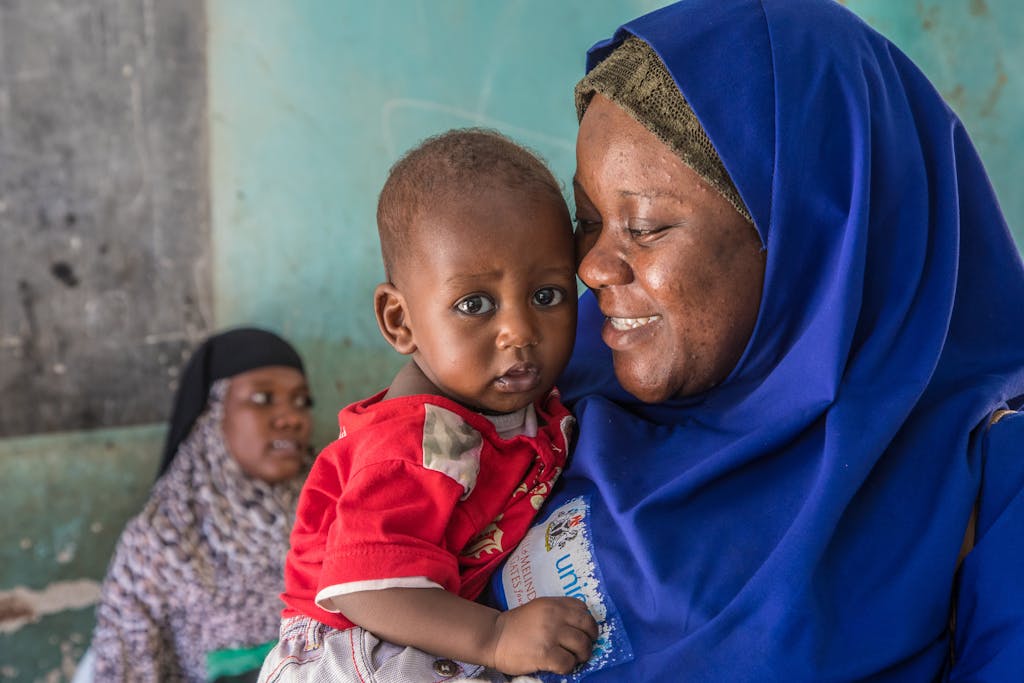Within five years the world has the chance to make polio a thing of the past, only the second disease in human history to be eradicated. The partnership tasked with finishing the job, the Global Polio Eradication Initiative, has a new, innovative strategy that builds on community-centered approaches, integrated services, and new technology to not only achieve the milestone of a polio-free world, but also help build strong, resilient health systems.
Walking through twisting and turning pathways, I follow a team of three community health workers through a neighborhood in Kano, Nigeria. It’s sticky and hot as the afternoon sun beats down, dust clouds the air, and the sounds of goats and motor scooters fill the surroundings. There are no street signs to guide us — only knowledgeable and trusted women from this community who know the way.
We turn a corner and come to a cement facade with a piece of fabric in the doorway. The team lead calls through the curtain and asks if we can come in. A woman sits on the floor just past the entry with a 5-month-old baby while her other children run around the courtyard. The team pulls out the health checkup card for the mother and baby and gets to work.

These community health workers are responsible for going house to house to check on families, looking for signs of fever or acute paralysis, an indication that a child may have poliovirus. They also are critical messengers of health, ensuring that families are up to date on their routine immunizations, providing breastfeeding or other nutritional support, and also monitoring for any emerging illnesses that need to be tracked.
A NEW STRATEGY TO ERADICATE POLIO
It may seem small scale, but these community health workers that I met on a pre-pandemic trip in 2019 are a vital part to achieving the goal of eradicating polio around the world, and they are central to the new strategy of the Global Polio Eradication Initiative (GPEI). They have made the difference in countries where wiping out polio was once thought impossible — places like Nigeria, which was just certified wild polio-free in August 2020.
Now, wild polio remains in just two countries: Afghanistan and Pakistan. It’s been hard to make progress in the last two polio-endemic countries, while also maintaining polio-free status in countries that are at high risk for outbreaks. The COVID-19 pandemic has made it even more difficult to reach eradication goals and sustain progress as health systems have been increasingly strained. In fact, 90% of countries say their essential health systems have been disrupted because of the pandemic. That means that millions of children have missed out on polio immunizations, and other essential health services, since the pandemic began.
During the recent World Health Assembly, Member States acknowledged disruptions to polio operations amid the COVID-19 pandemic and expressed growing enthusiasm for redoubling efforts and recalibrating the global strategy to fight polio.
Building on this momentum and commitment to achieve global eradication, GPEI just launched a new strategy to circumvent obstacles related to COVID-19 and to overcome previous challenges that have made eradicating polio challenging to date.
“The world has come so far in the fight to end polio, and we cannot afford to lose momentum now,” Mike McGovern, Chair of Rotary International’s PolioPlus Program, said during the strategy launch event on June 10.
The new strategy outlines what it will take to get us across the finish line to deliver on the promise of a polio-free world by 2026. It reinforces successful models like the use of trusted community health workers and social mobilizers, while also taking an innovative approach to employing new technology in immunization, and more integrated and inclusive health services.
GPEI recently developed a next-generation version of the existing oral polio vaccine, known as nOPV2, which has been found to be safe, effective, and more genetically stable. This new technology is expected to play a vital role in stopping wild polio infections from happening while also reducing the cases of what’s known as circulating vaccine-derived poliovirus, cases of polio that are picked up from waste in the environment in communities where the rate of immunizations is lower than it should be. The nOPV2 vaccine has already received Emergency Use Listing from the World Health Organization — preliminary authorization to deploy a novel test, treatment, or vaccine in cases of urgent public health emergencies — and is being used in a few countries with promising results so far. This new tool will be groundbreaking in the campaign to end polio.
IntegratiNG polio and other health services
It’s clear that doing business as usual won’t get the job done. That’s why GPEI has focused on enhanced integration of polio and other health services as a foundation of the new strategy. This includes integration of monitoring and surveillance with other health programs and partners like Gavi, The Vaccine Alliance, integrating ownership of health services and vaccine delivery into local communities. The programs also incorporate nutrition, education, hygiene, water, sanitation, and other critical services to more holistically address the basic needs of many populations in Afghanistan and Pakistan where possible.
For example, in high-risk districts of Pakistan, a new initiative to integrate additional services into polio vaccination campaigns helped reduce missed children and increased polio vaccine uptake. In one area of Quetta, a city in western Pakistan, vaccine refusals declined from over 700 families to just 19.
The strategy also includes ways to support countries in addressing gender-related barriers to polio vaccination and ensures that women are represented at all levels of operational and strategic decision-making. Taking a gender-responsive approach will help ensure that more communities will be reached and more children will receive vital immunizations.
Reducing the number of zero-dose children will be imperative if we want to see an end to polio once and for all. GPEI’s new road map offers a clear view of the path forward, keeping communities’ needs at its center. With this strategy, and concerted financing to achieve it, we have the ability to eradicate only the second disease in human history behind smallpox. What’s more, this new integrated approach will help create strong, resilient, and sustainable health systems that will be imperative to not only achieve and sustain a polio-free world, but also to prevent future health emergencies and deliver on the promise of health for all.
UN Foundation Global Health Fellow Logan Nesson contributed to this post.
Feature photo: Christine McNab/UN Foundation



 View All Blog Posts
View All Blog Posts
